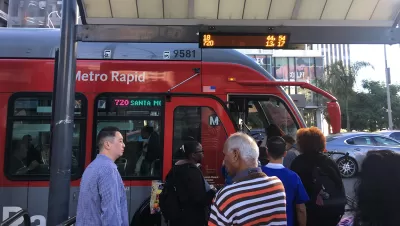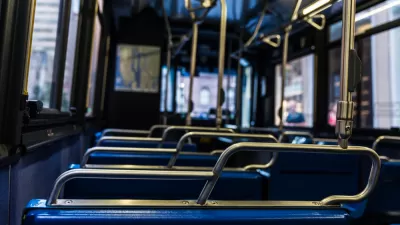A new report by the Bus Turnaround Coalition has a prescription to "build back better": fix the bus.

The Bus Turnaround Coalition this week published a plan to leverage bus public transit as a key tool in a post-pandemic economic recovery in New York.
Mark Hallum shares details of the report in an article for AM New York: "Dubbed the Big Bus Comeback, the Bus Turnaround Coalition wants the MTA to launch all-door boarding with OMNY fare collection, implementing the Bronx bus network redesign, finish planning for the Queens network, procure bus-mounted cameras for lane enforcement and revise schedules to compensate for buses running faster."
According to Hallum, one big component of a comeback for bus transit in New York would be more dedicated bus infrastructure. Mayor Bill de Blasio launched a campaign to quickly install 20 miles of new bus lanes and busways in June 2020, just a few months into the COVID-19 pandemic, but has walked back much of that commitment due to opposition from councilmembers and local businesses.
Gersh Kuntzman picked up the news of the new report in an article for Streetbslog NYC, framing the report as evidence of how easy it could be to fix bus service. "This doesn't have to be so hard," writes Kuntzman. Kuntzman also notes that the MTA already has several of the plans included in the report in motion, and it also has a large cash infusion made possible by the $1.9 trillion "American Rescue Plan" bill recently approved by Congress an signed into law by President Joe Biden.
The Bus Turnaround Coalition is a collaboration between TransitCenter, the NYPIRG Straphangars Campaign, the Tri-State Transportation Campaign, and the Riders Alliance.
FULL STORY: Transit advocates tell MTA to get rolling on bus service improvements ahead of COVID-19 recovery

Maui's Vacation Rental Debate Turns Ugly
Verbal attacks, misinformation campaigns and fistfights plague a high-stakes debate to convert thousands of vacation rentals into long-term housing.

Planetizen Federal Action Tracker
A weekly monitor of how Trump’s orders and actions are impacting planners and planning in America.

In Urban Planning, AI Prompting Could be the New Design Thinking
Creativity has long been key to great urban design. What if we see AI as our new creative partner?

King County Supportive Housing Program Offers Hope for Unhoused Residents
The county is taking a ‘Housing First’ approach that prioritizes getting people into housing, then offering wraparound supportive services.

Researchers Use AI to Get Clearer Picture of US Housing
Analysts are using artificial intelligence to supercharge their research by allowing them to comb through data faster. Though these AI tools can be error prone, they save time and housing researchers are optimistic about the future.

Making Shared Micromobility More Inclusive
Cities and shared mobility system operators can do more to include people with disabilities in planning and operations, per a new report.
Urban Design for Planners 1: Software Tools
This six-course series explores essential urban design concepts using open source software and equips planners with the tools they need to participate fully in the urban design process.
Planning for Universal Design
Learn the tools for implementing Universal Design in planning regulations.
planning NEXT
Appalachian Highlands Housing Partners
Gallatin County Department of Planning & Community Development
Mpact (founded as Rail~Volution)
City of Camden Redevelopment Agency
City of Astoria
City of Portland
City of Laramie





























